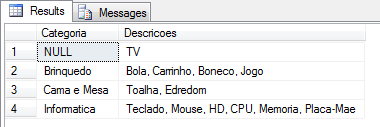String manipulation is a process to generate another form of existing data in a way the business uses or displayed as in the reports. The function returns the value of the first of its input parameters that is not NULL. The COALESCE expression is a syntactic shortcut for the CASE expression. During the expression evaluation process, Null values are generally replaced with user-defined values. COALESCE COALESCE akceptuje serie wartości z listy wyników, które mogą być puste (NULL) potem ona zwraca pierwszą nie pustą wartość z tej listy.

Taka funkcjonalność daje wiele kreatywnych użyć w bazie Sql Server. Tabelka PeopleNames zawiera kolumnę “Middle Name”, która może być pusta w końcu nie każda osoba ma drugie imię. I have the following: Select Coalesce (Other,Industry) Ind from registration The thing is that Other can be an empty string or NULL. Using Coalesce For Comma Delimited List. CASE is used in more circumstances, but when replacing NULL, COALESCE is a handy shortcut!
The Coalesce function in SQL server is used to define the Null values. If you haven’t done so already, check out these string functions to manipulate text data! MySQL COALESCE () function returns the first non-NULL value of a list, or NULL if there are no non-NULL values. Using SQL COALESCE for substituting NULL values.
When working with the data in the database table, you often use the COALESCE function to substitute a default value for a NULL value. Suppose you have to display the products on a web page with all information in the products table. Some products may not have the summary but the other do. If it has, then append a comma, then append the city.
Ask Question Asked years, months ago. I did not know that SQL string concatenation behaves so differently. Postgresql COALESCE with String Literals does not work as expected.
Because the COALESCE is an expression, you can use it in any clause that accepts an expression such as SELECT, WHERE, GROUP BY, and HAVING. Let’s see practical examples of using the COALESCE expression. The 1Keydata SQL Tutorial teaches beginners the building blocks of SQL. This section explains the COALESCE function.
Remember, COALESCE () is a standard function and whenever you can use COALESCE () you should be using it. Coalesce and empty strings to replace NULL - need help – Learn more on the SQLServerCentral forums. SQL Server COALESCE expression examples. I have three different sample T-sqls that almost produce the same result except the sql.
All you have to do is, declare a varchar variable and inside the coalesce , concat the variable with comma and the column, then assign the. It returns the first argument that is not null. If all arguments are null, the COALESCE function will return null. All the remaining arguments from the first non-null argument are not evaluated. Funkcje ISNULL oraz COALESCE wspierają nas przy pracy z wartościami NULL.
Obie te funkcje spełniają tę sama rolę lecz ich zachowanie się różni. In SQL, you can use a CASE expression to change the contents of a table field from a definite value to a null value. The null value indicates that you no longer know the field’s value. Consider the following example. For instance, you can generalize its use, as well optimize its performance and make its constantly available.
The rest of them are NULLs, because the middle name was also NULL (while concatenating strings with NULL value, the result is also NULL). How to Tackle SQL NULLs: COALESCE function. Such a result doesn’t looks very nice. The result don’t show the full name of students with no middle name.
In case of two expressions, the COALESCE () function and NVL() seems to be similar but their implementations are different. These functions are used to find Non-NULL values from a list of arguments. In this post, we will see the uses of the ISNULL and COALESCE functions.
Ponieważ wartości nieokreślone są często spotykane w bazach, musimy sobie jakoś z nimi radzić. Tylko w jaki sposób je traktować. Pawdopodobnie przy operacjach matematycznych, chcielibyśmy traktować NULL jak natomiast w wyrażeniach łączącym stringi – interpretować jako string pusty ”.
Brak komentarzy:
Prześlij komentarz
Uwaga: tylko uczestnik tego bloga może przesyłać komentarze.